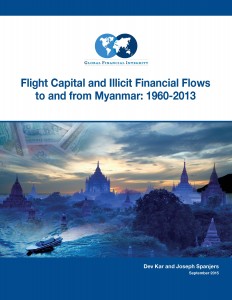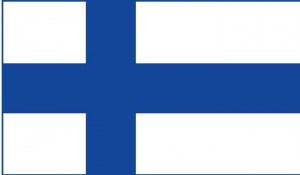This September 2015 study from Global Financial Integrity found that nearly US$100 billion flowed illegally through Myanmar between 1960 and 2013— draining domestic resources, driving the underground economy, exacerbating inequality, and facilitating crime and corruption.
This report was funded by a grant from the Government of Finland.
[wptab name=’Overview’]
Overview
Primary Findings
Illicit financial flows from Myanmar totaled US$18.7 billion from 1960 through 2013, with annual average illicit outflows averaging 6.5 percent of the country’s GDP.
Furthermore, the report found that illicit outflows are growing. Annual average illicit outflows increased from under US$400 million per annum in the 1960s to an average of US$8 billion today. Illicit inflows totaled a staggering US$77.7 billion over the 54-year period; nearly half of those inflows (in real terms) occurred during the last four years of the study, 2010-2013. On average, Myanmar’s illicit inflows are equivalent to 14.4 percent of its GDP.
Both the inward and outward illicit movements of money deprive the government of crucial tax revenue. By applying relevant tax rates on illicit flow figures, the report estimates lost tax revenue due to illicit flows and compares it to Myanmar’s public spending on health and education.
Policy Recommendations
“Addressing the problem of capital flight and illicit flows is crucial to the policy reforms Myanmar is pursuing as it opens to the world,” stated Tom Cardamone, GFI’s Managing Director, who will launch the report at an event Thursday afternoon in Washington, DC. “Illicit financial flows are a real and rapidly growing problem, as our research shows, one which requires serious attention by policymakers.”
GFI recommends a number of steps Myanmar’s next government can take to ameliorate the problem of illicit financial flows from the country revolving around two principles:
- Greater transparency in domestic and international financial transactions.
- Greater cooperation between governments to shut down the channels through which illicit money flows.
These steps include implementing a real-time world market pricing risk analysis system to curtail trade misinvoicing, making more meaningful progress on AML/CFT responsibilities, studying physical and technical smuggling routes to form the basis of an organized and effective program to curb these illegal transactions, and developing an internal review process that determines the highest priority areas for technical assistance.
Broad Flight Capital
In addition to estimating illicit flows of capital to and from Myanmar, the study also estimates that broad capital flight—a combination consisting of both licit and illicit flows—amounted to US$35.9 billion in outflows between 1960 and 2013. Broad flight capital inflows stood at US$82.8 billion.
Underground Economy
The report also found that the underground economy averaged 55.1 percent of official GDP over the 54-year period, increasing from an average of 49.3 percent in the 1960s to 66.1 percent in the 1980s before falling from 2008 through 2013, potentially as a result of increasing economic openness.
The study finds that total illicit financial flows drive and are driven by the underground economy, implying that efforts to curtail illicit financial flows would also significantly reduce the size of the underground
economy.
Methodology
The study is a methodologically rigorous analysis of illicit financial flows. Dr. Kar—assisted by GFI Junior Economist Joseph Spanjers—developed robust multi-equation economic models highlighting the interactions between illicit flows and the underground economy.
Nevertheless, Dr. Kar cautioned that the methodology for estimating illicit flows is very conservative and that there are likely to be more illicit flows from Myanmar that are not captured by the estimates, particularly given its complex history with regards to international sanctions and drug trafficking.
“The estimates provided by our methodology are likely to be extremely conservative as they do not include trade misinvoicing in services, same-invoice trade misinvoicing, hawala transactions, and dealings conducted in bulk cash,” explained Dr. Kar. “This means that a large amount of the proceeds of abusive transfer pricing between arms of the same multinational corporation as well as much of the earnings from drug trafficking, human smuggling, and other criminal activities—which are often settled in cash—are not included in these estimates.”
[/wptab]
[wptab name=’Read the Report’]
Read the Report
The full PDF of the report can be downloaded here. Additionally, the full report can be read in the Scribd window below.
[wptab1 name=’English’ set=’1′]
Flight Capital and Illicit Financial Flows to and from Myanmar: 1960-2013
[/wptab1]
[end_wptabset1 set=’1′]
[/wptab]
[wptab name=’Acknowledgements’]
Acknowledgements
About the Authors
Dev Kar is Global Financial Integrity’s Chief Economist, having formerly served as a Senior Economist at the International Monetary Fund.
Joseph Spanjers is a Junior Economist at Global Financial Integrity.
Contributions
The authors wish to thank and acknowledge Raymond Baker (President), Tom Cardamone (Managing Director), Christine Clough (Program Manager), Clark Gascoigne (Communications Director), Channing May (Policy Associate), Loosi Azarian (Administrative Assistant), Uyen Le (Economics Intern), Yuchen Ma (Economics Intern), and Emily Armstrong (Policy Intern) for their contributions to the production of this report.
GFI and the authors would also like to acknowledge Gil Leigh of Modern Media for his contributions to the layout and design of the publication.
Funding
Funding for this report was generously provided by the Government of Finland.
[/wptab]
[end_wptabset skin=”gray” location=”top” ]



